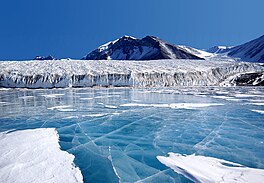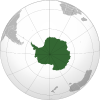|
Lake Fryxell
Lake Fryxell is a frozen lake 4.5 kilometres (2.8 mi) long, between Canada Glacier and Commonwealth Glaciers at the lower end of Taylor Valley in Victoria Land, Antarctica. It was mapped in the early 1900s and named during Operation Deep Freeze in the 1950s. There are several forms of algae living in the waters[1] and a weather station located at the lake.[2] GeographyLake Fryxell is 20 metres (66 ft) deep, so that the deepest portion of the lake is below sea level. The lake is dammed by Canada Glacier, so that it has no natural outflow. It is covered with about 4.5 metres (15 ft) of ice, but during the summer months, the ice can clear along the shoreline. There are a few small islands as well as several shallow areas.[1][3] The average annual ablation is between 30 centimetres (12 in) and 40 centimetres (16 in), which is significantly lower when compared to other nearby frozen water bodies, such as the waters adjacent to Ross Island.[4] WatershedThe watershed contains thirteen streams flowing into the lake, forming a watershed that has an area roughly 230 km2 (89 sq mi) in size. Where a few of the streams enter the lake there are well-developed deltas.[1] The streams flow for about 4–12 weeks out of the year. Nearly half of the water flowing into the lake comes from Canada, Lost Seal, and Von Guerard streams.[5] ClimateLake Fryxell is located within the McMurdo Dry Valleys, which experience an exceptionally dry climate partially due to katabatic winds descending from the nearby mountains. These winds can exceed 320 km/h (200 mph) under certain conditions and can raise the temperature, melting snow and evaporating water.[6][7] Average precipitation in the area surrounding the valley is equivalent to about 3 cm (1.2 in) of rain a year and a mean annual temperature of −20 °C (−4 °F) with summer temperatures getting above freezing.[5]
Lake Fryxell Camp
Mapped by the British Antarctic Expedition under Robert Falcon Scott, 1910–13, the lake was visited by Professor T.L. Péwé during Operation Deep Freeze, 1957–58, who named it for Dr. Fritiof M. Fryxell, glacial geologist of Augustana College, Illinois. Lake Fryxell is a focus of scientific research and contains a semi-permanent camp containing four labs and two other buildings. Electricity is generated at the camp using solar panels and a wind turbine. The four labs are used for experimenting with radioactive materials, electronics, chemicals and other materials. When staying at the camp, researchers sleep in tents, some of which are the same style as those used in some Antarctic expeditions in the early 20th century. There is internet and phone access at the camp.[9] Research activities largely deal with the lake itself and can include scientists diving into the water.[10] The camp has existed since at least 1984.[11] EcologyThere are multiple forms of algae within the lake, including a sizable population of sulfate-reducing bacteria. Some samples of these bacteria live in very specific areas, such as specific water depths or locations causing them to experience differing physiochemical conditions.[12] There are also a few archaea living in the anoxic zone, that contribute to the methane pockets under 12 m below the surface.[13] There is a lack of oxygen within Lake Fryxell, which is unique when compared to other lakes in the region because the euphotic zone only extends to 9 metres (30 ft) below the lake surface.[14] This creates an environment similar to the planet about 2.4 billion years ago. Within anoxic areas, scientists have found microbial mats that create small pockets saturated with oxygen.[10][15] See alsoReferences
External linksWikimedia Commons has media related to Lake Fryxell. |
||||||||||||||||||||||||||||||||||||||||||||||||||||||||||||||||||||||||||||||||||||||||||||||||||||||||||||||||||||||||||||||||||||




